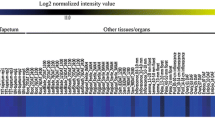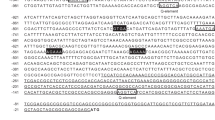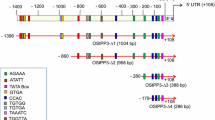Abstract
Late stage pollen-specific promoters are important tools in crop molecular breeding. Several such promoters, and their functional motifs, have been well characterized in dicotyledonous plants such as tomato and tobacco. However, knowledge about the functional architecture of such promoters is limited in the monocotyledonous plant rice. Here, pollen-late-stage-promoter 1 (PLP1) and pollen-late-stage-promoter 2 (PLP2) were characterized using a stable transformation system in rice. Histochemical staining showed that the two promoters exclusively drive GUS expression in late-stage pollen grains in rice. 5′ deletion analysis revealed that four regions, including the −1159 to −720 and the −352 to −156 regions of PLP1 and the −740 to −557 and the −557 to −339 regions of PLP2, are important in maintaining the activity and specificity of these promoters. Motif mutation analysis indicated that ‘AGAAA’ and ‘CAAT’ motifs in the −740 to −557 region of PLP2 act as enhancers in the promoter. Gain of function experiments indicated that the novel TA-rich motif ‘TACATAA’ and ‘TATTCAT’ in the core region of the PLP1 and PLP2 promoters is necessary, but not sufficient, for pollen-specific expression in rice. Our results provide evidence that the enhancer motif ‘AGAAA’ is conserved in the pollen-specific promoters of both monocots and eudicots, but that some functional architecture characteristics are different.








Similar content being viewed by others
References
Bate N, Twell D (1998) Functional architecture of a late pollen promoter: pollen-specific transcription is developmentally regulated by multiple stage-specific and co-dependent activator elements. Plant Mol Biol 37:859–869
Benfey PN, Ren L, Chua NH (1989) The CaMV 35S enhancer contains at least two domains which can confer different developmental and tissue-specific expression patterns. EMBO J 8:2195–2202
Boschen S (2009) Hybrid regimes of knowledge? Challenges for constructing scientific evidence in the context of the GMO-debate. Environ Sci Pollut R 16:508–520
Bradford MM (1976) A rapid and sensitive method for the quantitation of microgram quantities of protein utilizing the principle of protein-dye binding. Anal Biochem 72:248–254
Bruce WB, Christensen AH, Klein T, Fromm M, Quail PH (1989) Photoregulation of a phytochrome gene promoter from oat transferred into rice by particle bombardment. Proc Natl Acad Sci U S A 86:9692–9696
Cai M, Wei J, Li X, Xu C, Wang S (2007) A rice promoter containing both novel positive and negative cis-elements for regulation of green tissue-specific gene expression in transgenic plants. Plant Biotechnol J 5:664–674
Chapman GP (1987) The tapetum. Int Rev Cytol 107:111–125
Chen L, Tu ZM, Hussain J, Cong L, Yan YJ, Jin L, Yang GX, He GY (2010) Isolation and heterologous transformation analysis of a pollen-specific promoter from wheat (Triticum aestivum L.). Mol Biol Rep 37:737–744
Chen L, Miao YJ, Wang C, Su PP, Li TH, Wang R, Hao XL, Yang GX, He GY, Gao CB (2012) Characterization of a novel pollen-specific promoter from wheat (Triticum Aestivum L.). Plant Mol. Biol. Rep. 30:1426–1432
Cheon BY, Kim HJ, Oh KH, Bahn SC, Ahn JH, Choi JW, Ok SH, Bae JM, Shin JS (2004) Overexpression of human erythropoietin (EPO) affects plant morphologies: retarded vegetative growth in tobacco and male sterility in tobacco and Arabidopsis. Transgenic Res 13:541–549
Christensen AH, Quail PH (1996) Ubiquitin promoter-based vectors for high-level expression of selectable and/or screenable marker genes in monocotyledonous plants. Transgenic Res 5:213–218
Christensen AH, Sharrock RA, Quail PH (1992) Maize polyubiquitin genes: structure, thermal perturbation of expression and transcript splicing, and promoter activity following transfer to protoplasts by electroporation. Plant Mol Biol 18:675–689
Cockburn A (2002) Assuring the safety of genetically modified (GM) foods: the importance of an holistic, integrative approach. J Biotechnol 98:79–106
Denning GL, Mew TW (1998) China and IRRI: Improving China’s rice productivity in the 21st century. International Rice Research Institute, Manila
Fang RX, Nagy F, Sivasubramaniam S, Chua NH (1989) Multiple cis regulatory elements for maximal expression of the cauliflower mosaic virus 35S promoter in transgenic plants. Plant Cell 1:141–150
Filichkin SA, Leonard JM, Monteros A, Liu PP, Nonogaki H (2004) A novel endo-beta-mannanase gene in tomato LeMAN5 is associated with anther and pollen development. Plant Physiol 134:1080–1087
Frewer LJ, van der Lans IA, Fischer ARH, Reinders MJ, Menozzi D, Zhang XY, van den Berg I, Zimmermann KL (2013) Public perceptions of agri-food applications of genetic modification—a systematic review and meta-analysis. Trends Food Sci. Tech 30:142–152
Gardner N, Felsheim R, Smith AG (2009) Production of male- and female-sterile plants through reproductive tissue ablation. J Plant Physiol 166:871–881
Glover J, Grelon M, Craig S, Chaudhury A, Dennis E (1998) Cloning and characterization of MS5 from Arabidopsis: a gene critical in male meiosis. Plant J 15:345–356
Hamilton DA, Schwarz YH, Mascarenhas JP (1998) A monocot pollen-specific promoter contains separable pollen-specific and quantitative elements. Plant Mol Biol 38:663–669
Hiei Y, Ohta S, Komari T, Kumashiro T (1994) Efficient transformation of rice (Oryza sativa L.) mediated by Agrobacterium and sequence analysis of the boundaries of the T-DNA. Plant J 6:271–282
Higo K, Ugawa Y, Iwamoto M, Korenaga T (1999) Plant cis-acting regulatory DNA elements (PLACE) database: 1999. Nucleic Acids Res 27:297–300
Hsu SW, Liu MC, Zen KC, Wang CS (2014) Identification of the tapetum/microspore-specific promoter of the pathogenesis-related 10 gene and its regulation in the anther of Lilium longiflorum. Plant Sci 215:124–133
Huang ZY, Gan ZS, He YS, Li YH, Liu XD, Mu H (2011) Functional analysis of a rice late pollen-abundant UDP-glucose pyrophosphorylase (OsUgp2) promoter. Mol Biol Rep 38:4291–4302
Jefferson RA (1987) Assaying chimeric genes in plant: the GUS gene fusion system. Plant Mol Biol Rep 5:387–405
Jefferson RA, Kavanagh TA, Bevan MW (1987) GUS fusions: beta-glucuronidase as a sensitive and versatile gene fusion marker in higher plants. EMBO J 6:3901–3907
Khurana R, Kapoor S, Tyagi AK (2012) Anthology of anther/pollen-specific promoters and transcription factors. Crit Rev Plant Sci 31:359–390
Khush GS (2005) What it will take to feed 5.0 billion rice consumers in 2030. Plant Mol Biol 59:1–6
Konagaya K, Ando S, Kamachi S, Tsuda M, Tabei Y (2008) Efficient production of genetically engineered, male-sterile Arabidopsisthaliana using anther-specific promoters and genes derived from Brassica oleracea and B. rapa. Plant Cell Rep 27:1741–1754
Kurek I, Stoger E, Dulberger R, Christou P, Breiman A (2002) Overexpression of the wheat FK506-binding protein 73 (FKBP73) and the heat-induced wheat FKBP77 in transgenic wheat reveals different functions of the two isoforms. Transgenic Res 11:373–379
Kuriakose B, Arun V, Gnanamanickam SS, Thomas G (2009) Tissue-specific expression in transgenic rice and Arabidopsis thaliana plants of GUS gene driven by the 5′ regulatory sequences of an anther specific rice gene YY2. Plant Sci 177:390–397
Lee YH, Chung KH, Kim HU, Jin YM, Kim HI, Park BS (2003) Induction of male sterile cabbage using a tapetum-specific promoter from Brassica campestris L. ssp pekinensis. Plant Cell Rep 22:268–273
Li SQ, Yang DC, Zhu YG (2007) Characterization and use of male sterility in hybrid rice breeding. J Integr Plant Biol 49:791–804
Liu Y, Cui S, Wu F, Yan S, Lin X, Du X, Chong K, Schilling S, Theissen G, Meng Z (2013) Functional conservation of MIKC*-type MADS box genes in Arabidopsis and rice pollen maturation. Plant Cell 25:1288–1303
Luo H, Lee JY, Hu Q, Nelson-Vasilchik K, Eitas TK, Lickwar C, Kausch AP, Chandlee JM, Hodges TK (2006) RTS, a rice anther-specific gene is required for male fertility and its promoter sequence directs tissue-specific gene expression in different plant species. Plant Mol Biol 62:397–408
Mariani C, Debeuckeleer M, Truettner J, Leemans J, Goldberg RB (1990) Induction of male-sterility in plants by a chimeric ribonuclease gene. Nature 347:737–741
Mariani C, Gossele V, Debeuckeleer M, Deblock M, Goldberg RB, Degreef W, Leemans J (1992) A chimeric ribonuclease-inhibitor gene restores fertility to male sterile plants. Nature 357:384–387
Mascarenhas JP (1990) Gene activity during pollen development. Annu Rev Plant Phys 41:317–338
Matzke MA, Mette MF, Matzke AJ (2000) Transgene silencing by the host genome defense: implications for the evolution of epigenetic control mechanisms in plants and vertebrates. Plant Mol Biol 43:401–415
Mcelroy D, Brettell RIS (1994) Foreign gene-expression in transgenic cereals. Trends Biotechnol 12:62–68
Mcelroy D, Zhang WG, Cao J, Wu R (1990) Isolation of an efficient actin promoter for use in rice transformation. Plant Cell 2:163–171
Park JI, Hakozaki H, Endo M, Takada Y, Ito H, Uchida M, Okabe T, Watanabe M (2006) Molecular characterization of mature pollen-specific genes encoding novel small cysteine-rich proteins in rice (Oryza sativa L.). Plant Cell Rep 25:466–474
Paul W, Hodge R, Smartt S, Draper J, Scott R (1992) The isolation and characterisation of the tapetum-specific Arabidopsis thaliana A9 gene. Plant Mol Biol 19:611–622
Rogers HJ, Bate N, Combe J, Sullivan J, Sweetman J, Swan C, Lonsdale DM, Twell D (2001) Functional analysis of cis-regulatory elements within the promoter of the tobacco late pollen gene g10. Plant Mol Biol 45:577–585
Schrauwen JA, de Groot PF, van Herpen MM, van der Lee T, Reynen WH, Weterings KA, Wullems GJ (1990) Stage-related expression of mRNAs during pollen development in lily and tobacco. Planta 182:298–304
Shirsat A, Wilford N, Croy R, Boulter D (1989) Sequences responsible for the tissue specific promoter activity of a pea legumin gene in tobacco. Mol Gen Genet 215:326–331
Sinha NR, Williams RE, Hake S (1993) Overexpression of the maize homeo box gene, KNOTTED-1, causes a switch from determinate to indeterminate cell fates. Genes Dev 7:787–795
Swapna L, Khurana R, Kumar SV, Tyagi AK, Rao KV (2011) Pollen-specific expression of Oryza sativa Indica pollen allergen gene (OSIPA) promoter in rice and Arabidopsis transgenic systems. Mol Biotechnol 48:49–59
Toki S, Hara N, Ono K, Onodera H, Tagiri A, Oka S, Tanaka H (2006) Early infection of scutellum tissue with Agrobacterium allows high-speed transformation of rice. Plant J 47:969–976
Twell D, Klein TM, Fromm ME, Mccormick S (1989) Transient expression of chimeric genes delivered into pollen by microprojectile bombardment. Plant Physiol 91:1270–1274
Twell D, Yamaguchi J, Wing RA, Ushiba J, Mccormick S (1991) Promoter analysis of genes that are coordinately expressed during pollen development reveals pollen-specific enhancer sequences and shared regulatory elements. Gene Dev 5:496–507
Willing RP, Bashe D, Mascarenhas JP (1988) An analysis of the quantity and diversity of messenger RNAs from pollen and shoots of Zea mays. Theor Appl Genet 75:751–753
Zhang DB, Wilson ZA (2009) Stamen specification and anther development in rice. Chinese Sci Bull 54:2342–2353
Zhang WG, Mcelroy D, Wu R (1991) Analysis of rice act1 5′ region activity in transgenic rice plants. Plant Cell 3:1155–1165
Zhou P, Yang F, Yu JJ, Ao GM, Zhao Q (2010) Several cis-elements including a palindrome involved in pollen-specific activity of SBgLR promoter. Plant Cell Rep 29:503–511
Acknowledgments
We thank Dr. Hualiang Liu and Dr. Wenjing Li for their technical assistance with the GUS activity analysis. This work was supported by grants from The National Natural Science Foundation of China (Grant 31270280) and The Ministry of Science and Technology of China (Grant 2011CB100405).
Author information
Authors and Affiliations
Corresponding author
Electronic supplementary material
Below is the link to the electronic supplementary material.
Rights and permissions
About this article
Cite this article
Yan, S., Wang, Z., Liu, Y. et al. Functional architecture of two exclusively late stage pollen-specific promoters in rice (Oryza sativa L.). Plant Mol Biol 88, 415–428 (2015). https://doi.org/10.1007/s11103-015-0331-0
Received:
Accepted:
Published:
Issue Date:
DOI: https://doi.org/10.1007/s11103-015-0331-0




